In Situ Observations of Wind Turbines Wakes with Unmanned Aerial Vehicle BOREAL within the MOMEMTA Project
Abstract
:1. Introduction
2. Material and Methods
2.1. Observation of Wind Turbine Wakes with UAVs
2.2. The MOMENTA Project
2.2.1. Scientific Objectives
2.2.2. UAV Characteristics and Instrumentation
2.2.3. Wind Farm Site Description and Wind Turbine Characteristics
2.2.4. Flight Operations with BOREAL
3. Results and Discussion
3.1. Flight on 30 April 2021
3.1.1. Instantaneous Wind Series
3.1.2. Horizontal Fields
- The wind reduction in the wake area of T3 is observable for each of the two periods and at each of the two altitudes.
- This wind reduction is discernable behind the turbine down to about 400–500 m (~5D).
- The wake of T2 is on the edge on the interpolated fields and, thus, only appeared on the upper right field in the figure, thanks to the westernmost extension of three flight sequences during this flight phase.
- The wind strengthening behind the turbines line in the area between the T2 and T3 wakes is clear on all the plots except the upper right one. In this case, the area just behind T2 was not as well-covered as on the other plots, which explains the less discernable wind increase.
- Both the wind reduction behind the turbine and the wind increase between the turbine individual wakes seems to be more intense at 90 m (i.e., at a level just above the hub height) than at 110 m (just below the top of the blade disk). Porté-Agel et al., (2019) reported in their review paper that the maximum wind reduction was observed at the rotor level [2].
3.2. Flight on 28 April 2021
3.2.1. Instantaneous Wind Series
3.2.2. Horizontal Fields
4. Conclusions
Author Contributions
Funding
Institutional Review Board Statement
Informed Consent Statement
Data Availability Statement
Acknowledgments
Conflicts of Interest
References
- GWEC-Global-Wind-Report-2021. Available online: https://gwec.net/wp-content/uploads/2021/03/GWEC-Global-Wind-Report-2021.pdf (accessed on 17 March 2022).
- Porté-Agel, F.; Bastankhah, M.; Shamsoddin, S. Wind-Turbine and Wind-Farm Flows: A Review. Bound. Layer Meteorol. 2020, 174, 1–59. [Google Scholar] [CrossRef] [PubMed] [Green Version]
- Lissaman, P.B.S.; Zambrano, T.G.; Gyatt, G.W. Wake Structure Measurements at the Mod-2 Cluster Test Facility at Goodnoe Hills; PNL-4572; Pacific Northwest Laboratory: Washington, DC, USA, 1983; p. 6463031. [Google Scholar]
- Kumer, V.-M.; Reuder, J.; Svardal, B.; Sætre, C.; Eecen, P. Characterisation of Single Wind Turbine Wakes with Static and Scanning WINTWEX-W LiDAR Data. Energy Procedia 2015, 80, 245–254. [Google Scholar] [CrossRef] [Green Version]
- Hirth, B.D.; Schroeder, J.L.; Gunter, W.S.; Guynes, J.G. Coupling Doppler Radar-Derived Wind Maps with Operational Turbine Data to Document Wind Farm Complex Flows. Wind Energy 2015, 18, 529–540. [Google Scholar] [CrossRef]
- Stevens, R.; Gayme, D.; Meneveau, C. Coupled Wake Boundary Layer Model of Wind-Farms. J. Renew. Sustain. Energy 2014, 7, 023115. [Google Scholar] [CrossRef] [Green Version]
- Stevens, R.J.A.M.; Gayme, D.; Meneveau, C. Using the Coupled Wake Boundary Layer Model to Evaluate the Effect of Turbulence Intensity on Wind Farm Performance. J. Phys. Conf. Ser. 2015, 625, 012004. [Google Scholar] [CrossRef] [Green Version]
- Jensen, N.O. A Note on Wind Generator Interaction; Y RISØ-M-2411; Risø National Laboratory: Roskilde, Denmark, 1983. [Google Scholar]
- Neunaber, I.; Obligado, M.; Peinke, J.; Aubrun, S. Application of the Townsend-George Wake Theory to Field Measurements of Wind Turbine Wakes. J. Phys. Conf. Ser. 2021, 1934, 012004. [Google Scholar] [CrossRef]
- Maalouf, C.; Dobrev, I.; Massouh, F. Exploration Des Structures Tourbillonnaires Dans Le Sillage d’un Rotor Éolien. In Proceedings of the CFSER 2010 1ère Conférence Franco-Syrienne sur les énergies Renouvelables, Damascus, Syria, 24–28 October 2010. [Google Scholar]
- Yang, Z.; Sarkar, P.; Hu, H. Visualization of the Tip Vortices in a Wind Turbine Wake. J. Vis. 2012, 15, 39–44. [Google Scholar] [CrossRef]
- Odemark, Y. Wakes behind Wind Turbines—Studies on Tip Vortex Evolution and Stability. 2012. Available online: https://www.diva-portal.org/smash/get/diva2:524104/FULLTEXT01.pdf (accessed on 17 March 2022).
- Käsler, Y.; Rahm, S.; Simmet, R.; Kühn, M. Wake Measurements of a Multi-MW Wind Turbine with Coherent Long-Range Pulsed Doppler Wind Lidar. J. Atmos. Ocean. Technol. 2010, 27, 1529–1532. [Google Scholar] [CrossRef] [Green Version]
- Aitken, M.L.; Banta, R.M.; Pichugina, Y.L.; Lundquist, J.K. Quantifying Wind Turbine Wake Characteristics from Scanning Remote Sensor Data. J. Atmos. Ocean. Technol. 2014, 31, 765–787. [Google Scholar] [CrossRef]
- Wildmann, N.; Hofsäß, M.; Weimer, F.; Joos, A.; Bange, J. MASC—A Small Remotely Piloted Aircraft (RPA) for Wind Energy Research. Adv. Sci. Res. 2014, 11, 55–61. [Google Scholar] [CrossRef] [Green Version]
- Reuder, J.; Båserud, L.; Kral, S.; Kumer, V.; Wagenaar, J.W.; Knauer, A. Proof of Concept for Wind Turbine Wake Investigations with the RPAS SUMO. Energy Procedia 2016, 94, 452–461. [Google Scholar] [CrossRef] [Green Version]
- Medici, D.; Ivanell, S.; Dahlberg, J.-Å.; Alfredsson, P.H. The Upstream Flow of a Wind Turbine: Blockage Effect. Wind Energy 2011, 14, 691–697. [Google Scholar] [CrossRef]
- Ivanell, S.; Mikkelsen, R.; Sørensen, J.N.; Henningson, D. Stability Analysis of the Tip Vortices of a Wind Turbine. Wind Energy 2010, 13, 705–715. [Google Scholar] [CrossRef]
- Premaratne, P.; Hu, H. A Novel Vortex Method to Investigate Wind Turbine Near-Wake Characteristics. In 35th AIAA Applied Aerodynamics Conference; American Institute of Aeronautics and Astronautics: Denver, CO, USA, 2017. [Google Scholar]
- Sherry, M.; Nemes, A.; Lo Jacono, D.; Blackburn, H.M.; Sheridan, J. The Interaction of Helical Tip and Root Vortices in a Wind Turbine Wake. Phys. Fluids 2013, 25, 117102. [Google Scholar] [CrossRef] [Green Version]
- Yang, X.; Hong, J.; Barone, M.; Sotiropoulos, F. Coherent Dynamics in the Rotor Tip Shear Layer of Utility-Scale Wind Turbines. J. Fluid Mech. 2016, 804, 90–115. [Google Scholar] [CrossRef] [Green Version]
- Felli, M.; Camussi, R.; Felice, F.D. Mechanisms of Evolution of the Propeller Wake in the Transition and Far Fields. J. Fluid Mech. 2011, 682, 5–53. [Google Scholar] [CrossRef] [Green Version]
- Ashton, R.; Viola, F.; Camarri, S.; Gallaire, F.; Iungo, G.V. Hub Vortex Instability within Wind Turbine Wakes: Effects of Wind Turbulence, Loading Conditions, and Blade Aerodynamics. Phys. Rev. Fluids 2016, 1, 073603. [Google Scholar] [CrossRef]
- Coudou, N.; Buckingham, S.; Bricteux, L.; van Beeck, J. Experimental Study on the Wake Meandering Within a Scale Model Wind Farm Subject to a Wind-Tunnel Flow Simulating an Atmospheric Boundary Layer. Bound. Layer Meteorol. 2018, 167, 77–98. [Google Scholar] [CrossRef]
- Howard, K.B.; Singh, A.; Sotiropoulos, F.; Guala, M. On the Statistics of Wind Turbine Wake Meandering: An Experimental Investigation. Phys. Fluids 2015, 27, 075103. [Google Scholar] [CrossRef]
- Carbajo Fuertes, F.; Markfort, C.D.; Porté-Agel, F. Wind Turbine Wake Characterization with Nacelle-Mounted Wind Lidars for Analytical Wake Model Validation. Remote Sens. 2018, 10, 668. [Google Scholar] [CrossRef] [Green Version]
- McKay, P.; Carriveau, R.; Ting, D.S.-K. Wake Impacts on Downstream Wind Turbine Performance and Yaw Alignment. Wind Energy 2013, 16, 221–234. [Google Scholar] [CrossRef]
- Marathe, N.; Swift, A.; Hirth, B.; Walker, R.; Schroeder, J. Characterizing Power Performance and Wake of a Wind Turbine under Yaw and Blade Pitch. Wind Energy 2016, 19, 963–978. [Google Scholar] [CrossRef]
- Kocer, G.; Mansour, M.; Chokani, N.; Abhari, R.S.; Müller, M. Full-Scale Wind Turbine Near-Wake Measurements Using an Instrumented Uninhabited Aerial Vehicle. J. Sol. Energy Eng. 2011, 133, 041011. [Google Scholar] [CrossRef]
- Kocer, G.; Chokani, N.; Abhari, R.S. Detailed Measurements in the Wake of a 2MW Wind Turbine. In European Wind Energy Conference and Exhibition 2012, EWEC 2012, Copenhagen, Denmark, 16–19 April 2012; European Wind Energy Association: Brussels, Belgium, 2012; Volume 1, pp. 448–454. [Google Scholar]
- Mansour, M.; Kocer, G.; Lenherr, C.; Chokani, N.; Abhari, R.S. Seven-Sensor Fast-Response Probe for Full-Scale Wind Turbine Flowfield Measurements. J. Eng. Gas Turbines Power 2011, 133, 081601. [Google Scholar] [CrossRef]
- Rautenberg, A.; Allgeier, J.; Jung, S.; Bange, J. Calibration Procedure and Accuracy of Wind and Turbulence Measurements with Five-Hole Probes on Fixed-Wing Unmanned Aircraft in the Atmospheric Boundary Layer and Wind Turbine Wakes. Atmosphere 2019, 10, 124. [Google Scholar] [CrossRef] [Green Version]
- Båserud, L.; Flügge, M.; Bhandari, A.; Reuder, J. Characterization of the SUMO Turbulence Measurement System for Wind Turbine Wake Assessment. Energy Procedia 2014, 53, 173–183. [Google Scholar] [CrossRef] [Green Version]
- Mauz, M.; Rautenberg, A.; Platis, A.; Cormier, M.; Bange, J. First Identification and Quantification of Detached-Tip Vortices behind a Wind Energy Converter Using Fixed-Wing Unmanned Aircraft System. Wind Energy Sci. 2019, 4, 451–463. [Google Scholar] [CrossRef] [Green Version]
- Alaoui-Sosse, S.; Durand, P.; Medina, P.; Pastor, P.; Gavart, M.; Pizziol, S. BOREAL- A Fixed-Wing Unmanned Aerial System for the Measurement of Wind and Turbulence in the Atmospheric Boundary Layer. J. Atmos. Ocean. Technol. 2022, 39, 387–402. [Google Scholar] [CrossRef]
- Joulin, P.-A.; Mayol, M.L.; Masson, V.; Blondel, F.; Rodier, Q.; Cathelain, M.; Lac, C. The Actuator Line Method in the Meteorological LES Model Meso-NH to Analyze the Horns Rev 1 Wind Farm Photo Case. Front. Earth Sci. 2020, 7, 350. [Google Scholar] [CrossRef] [Green Version]

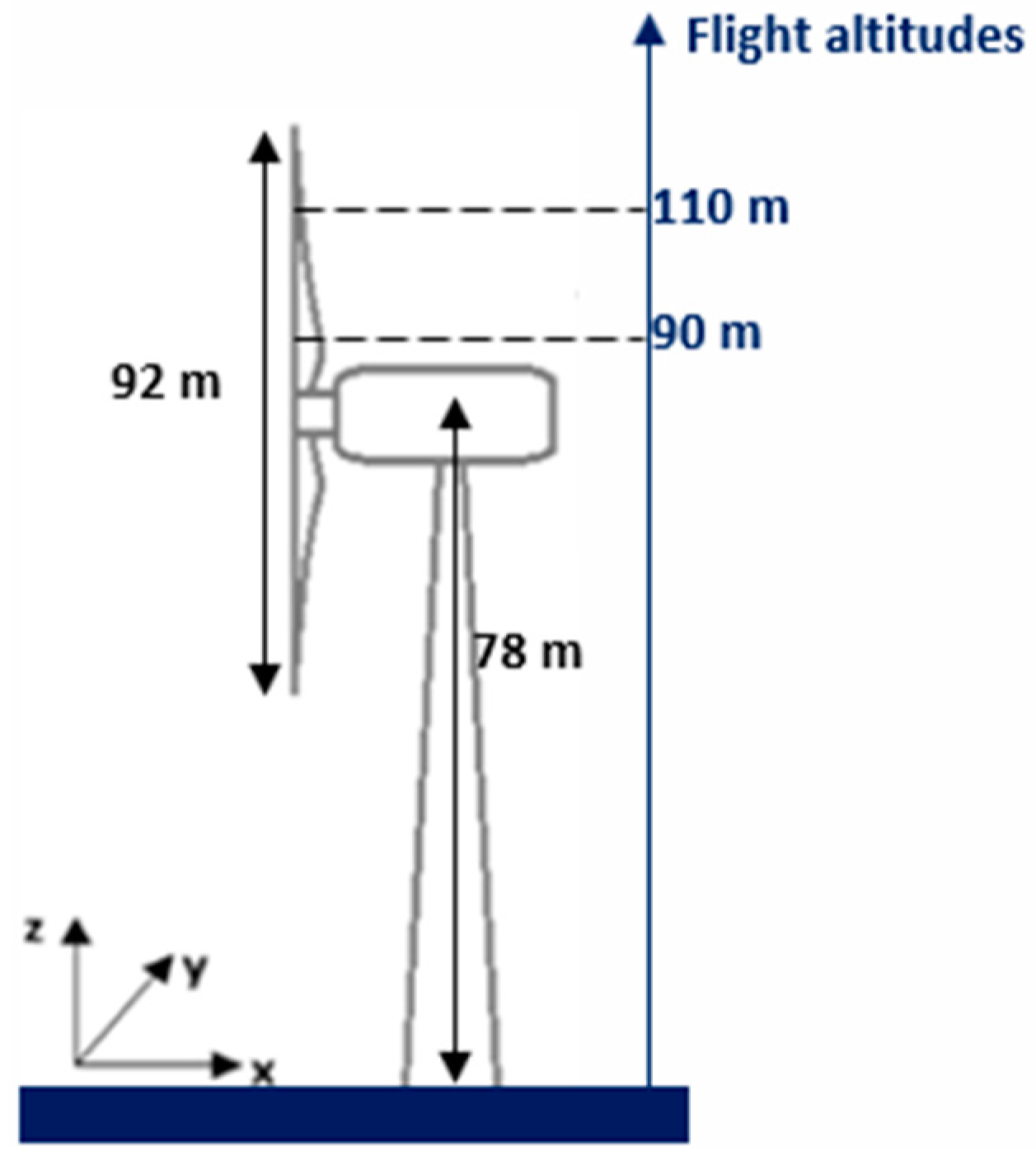
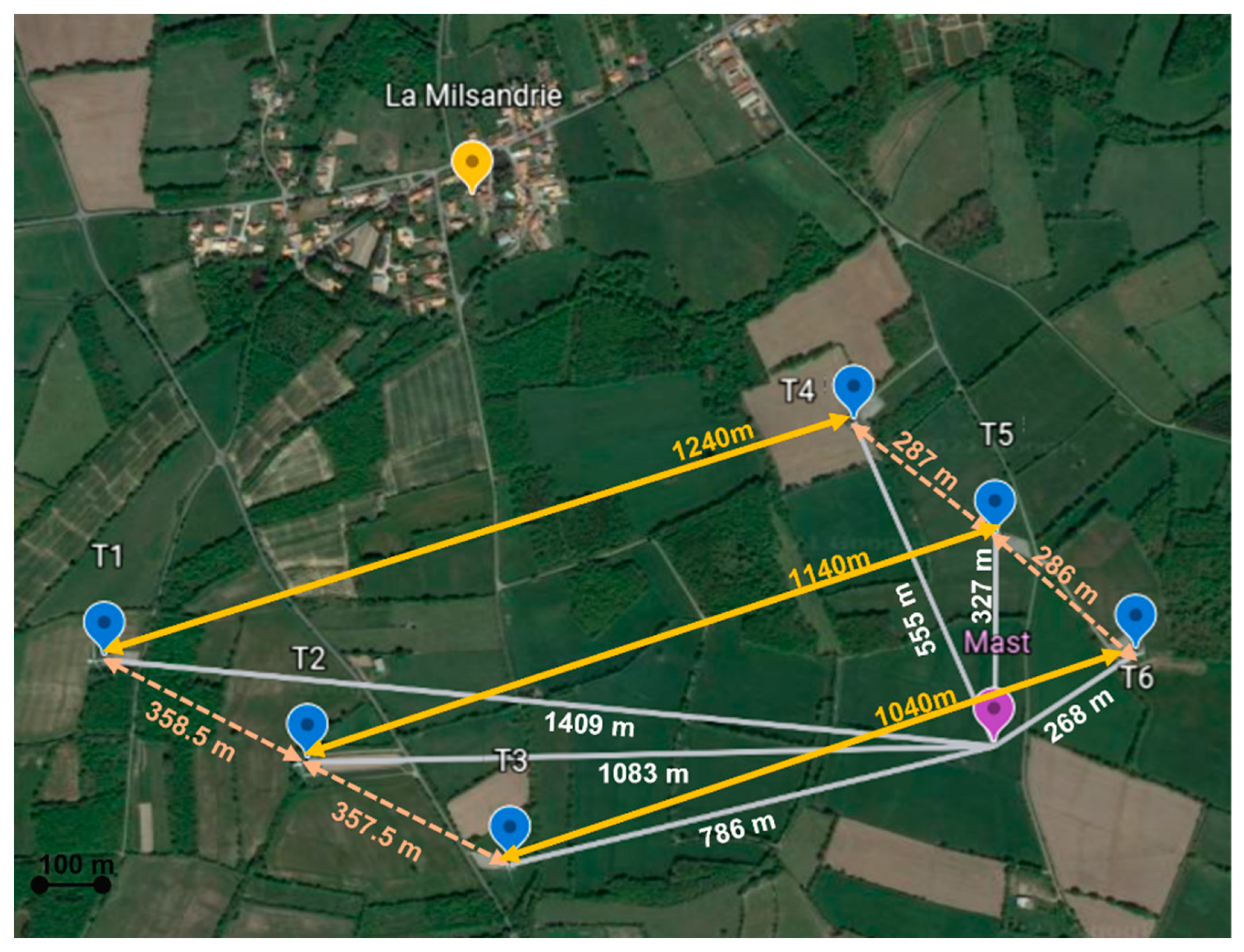
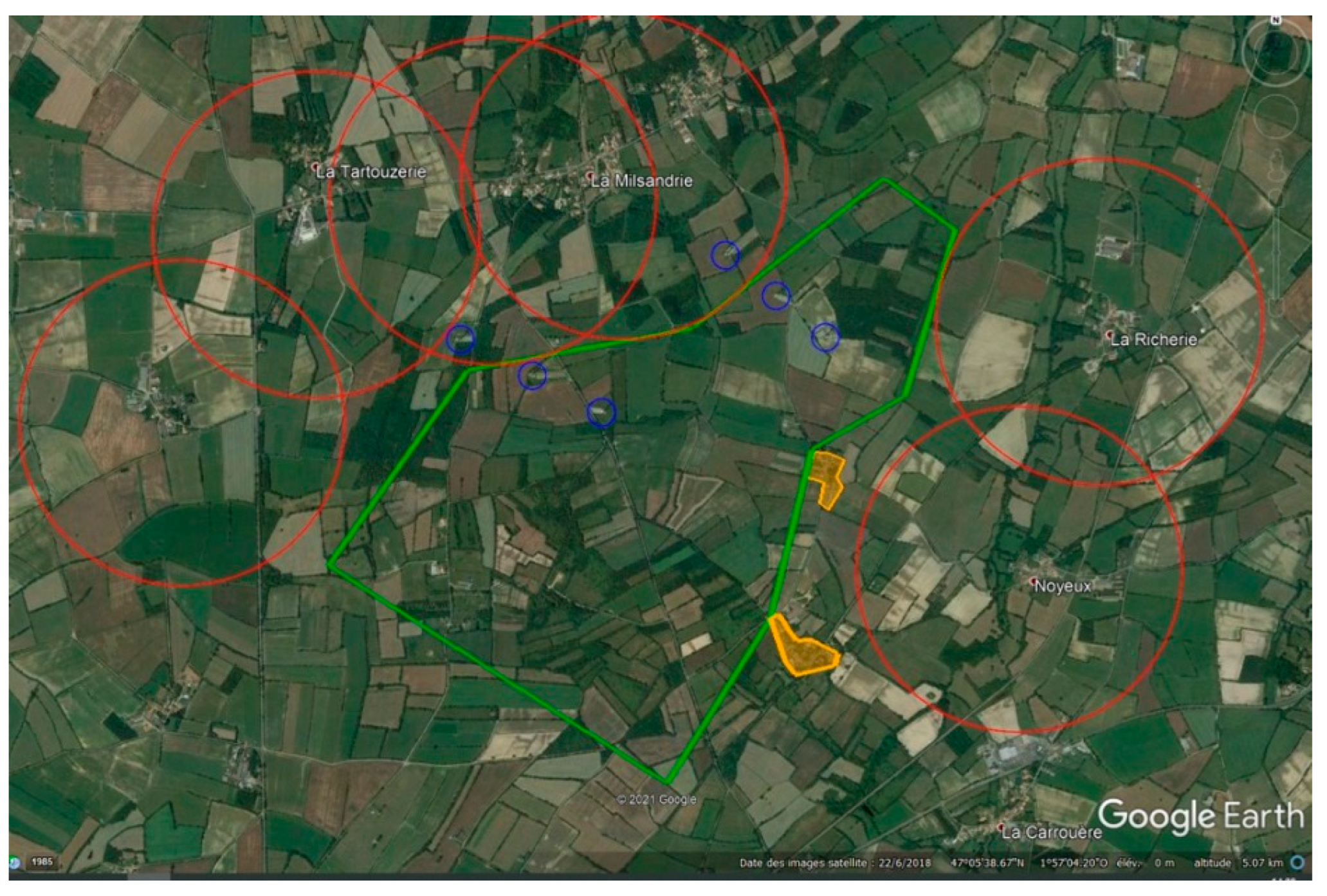
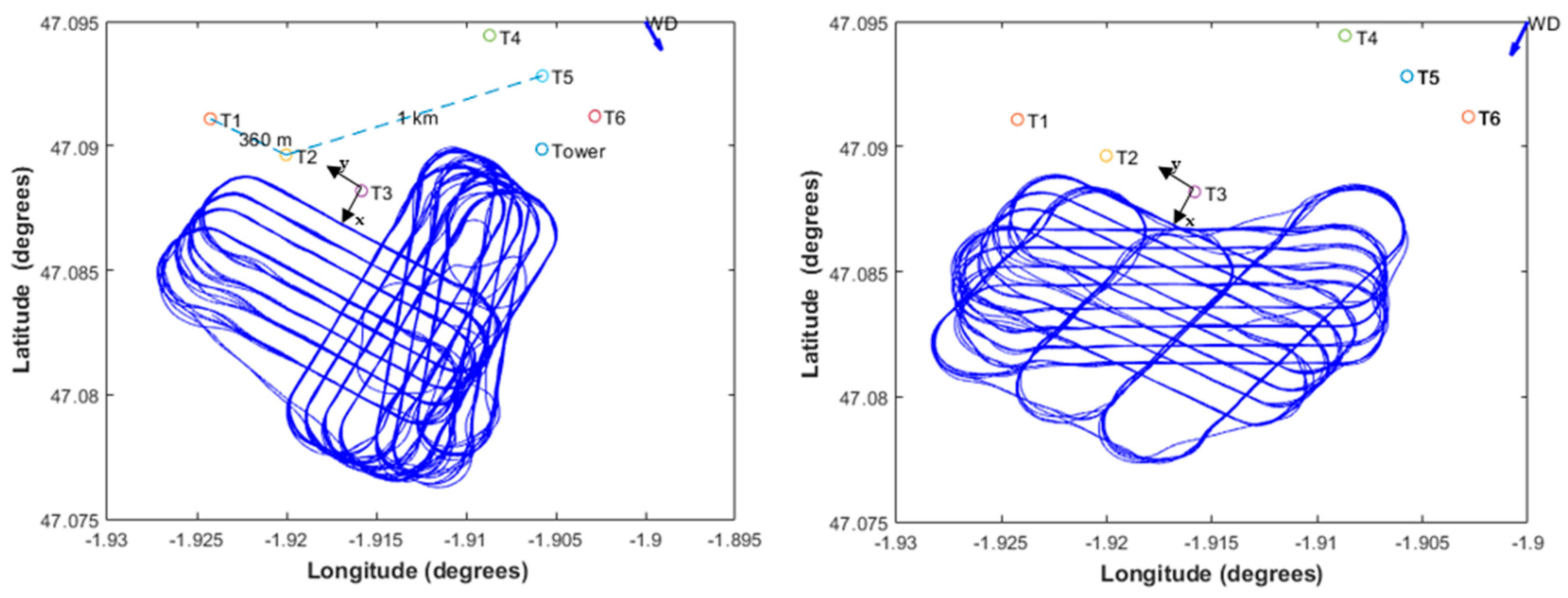
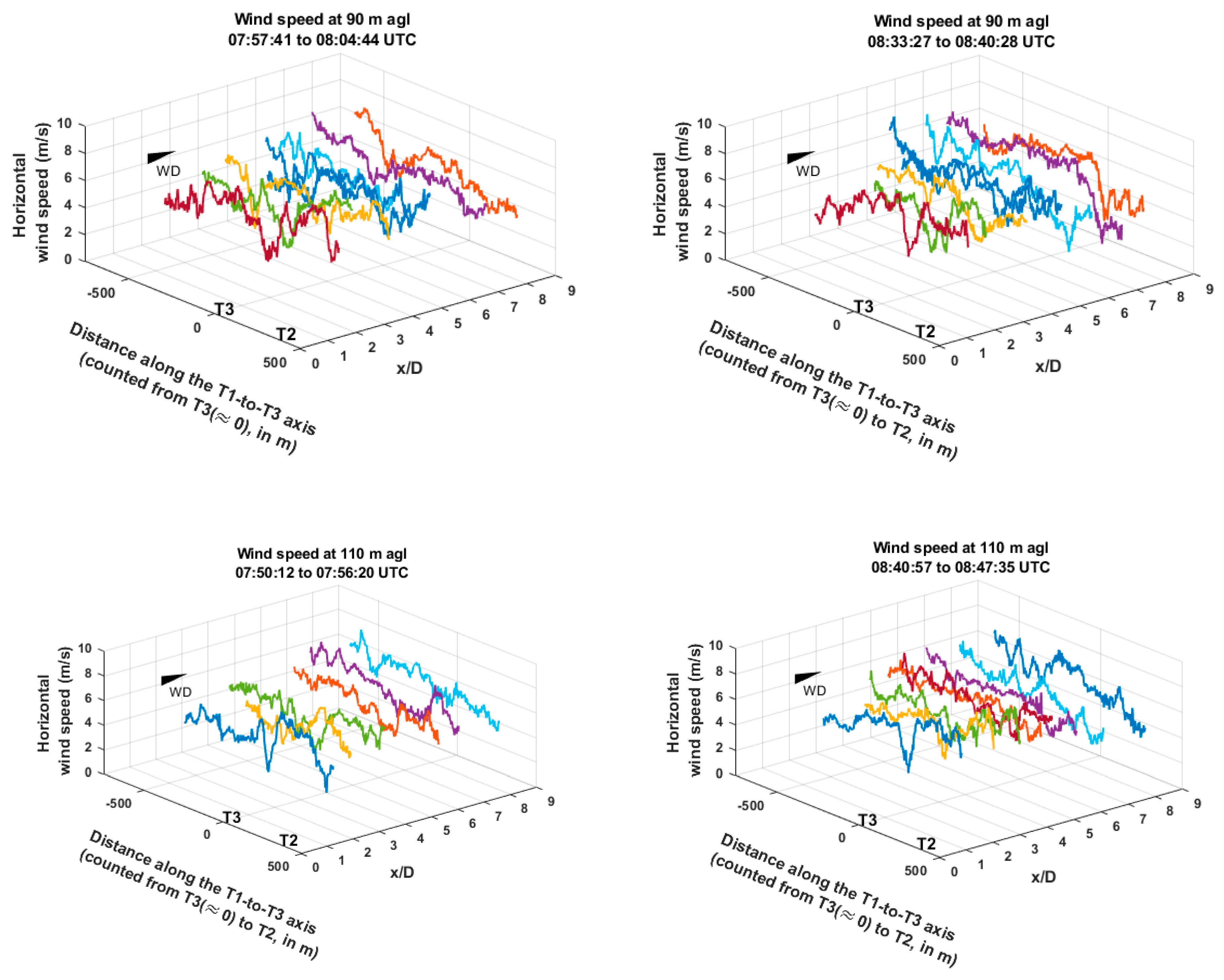
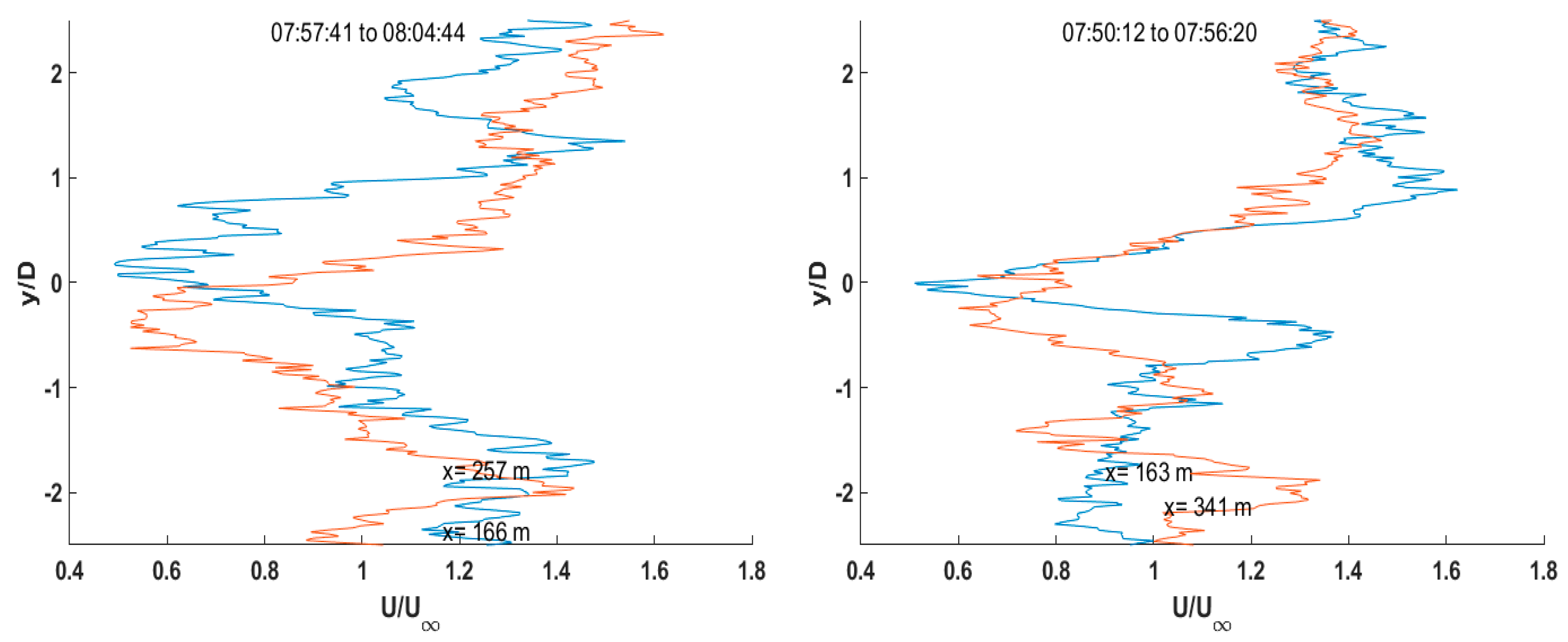
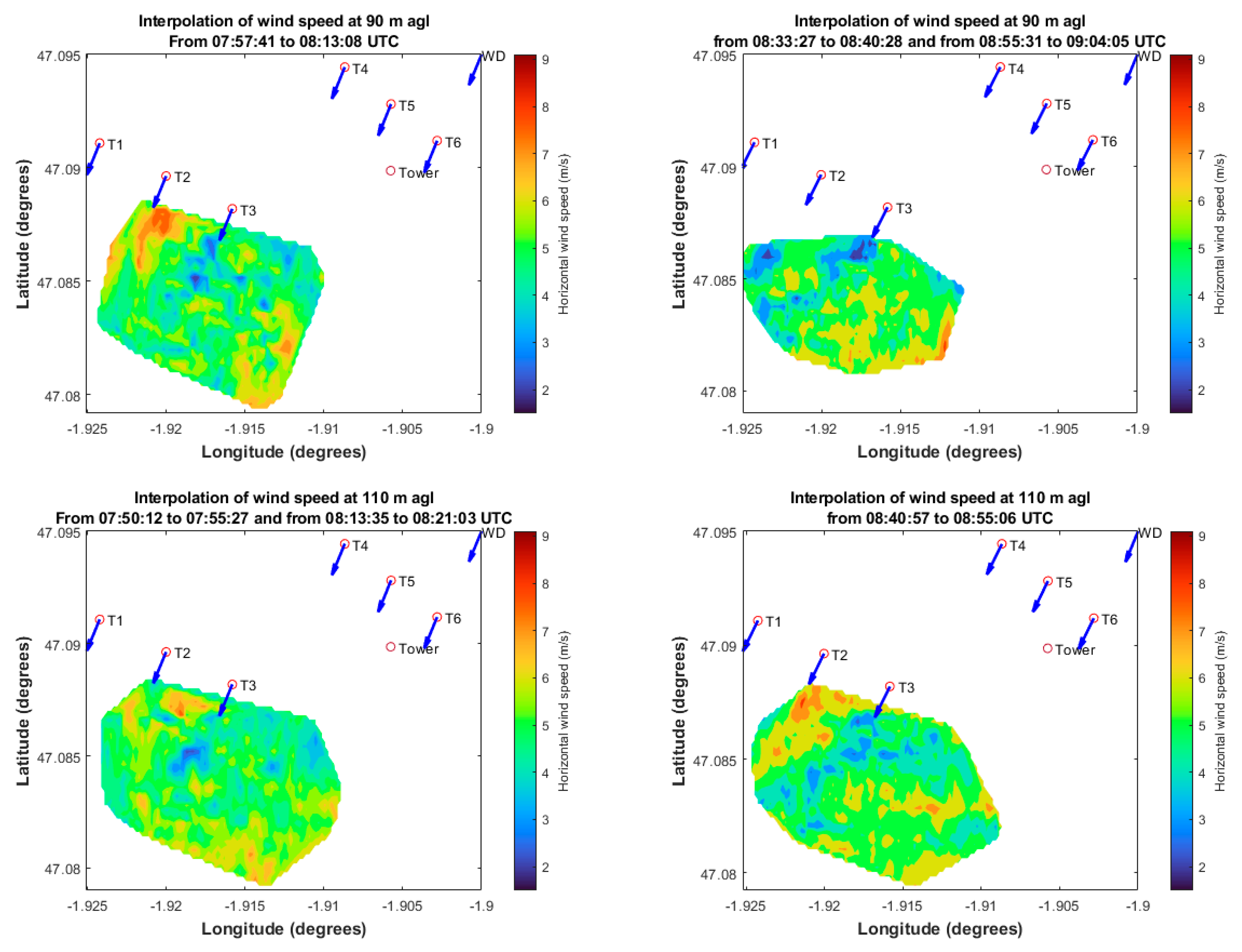

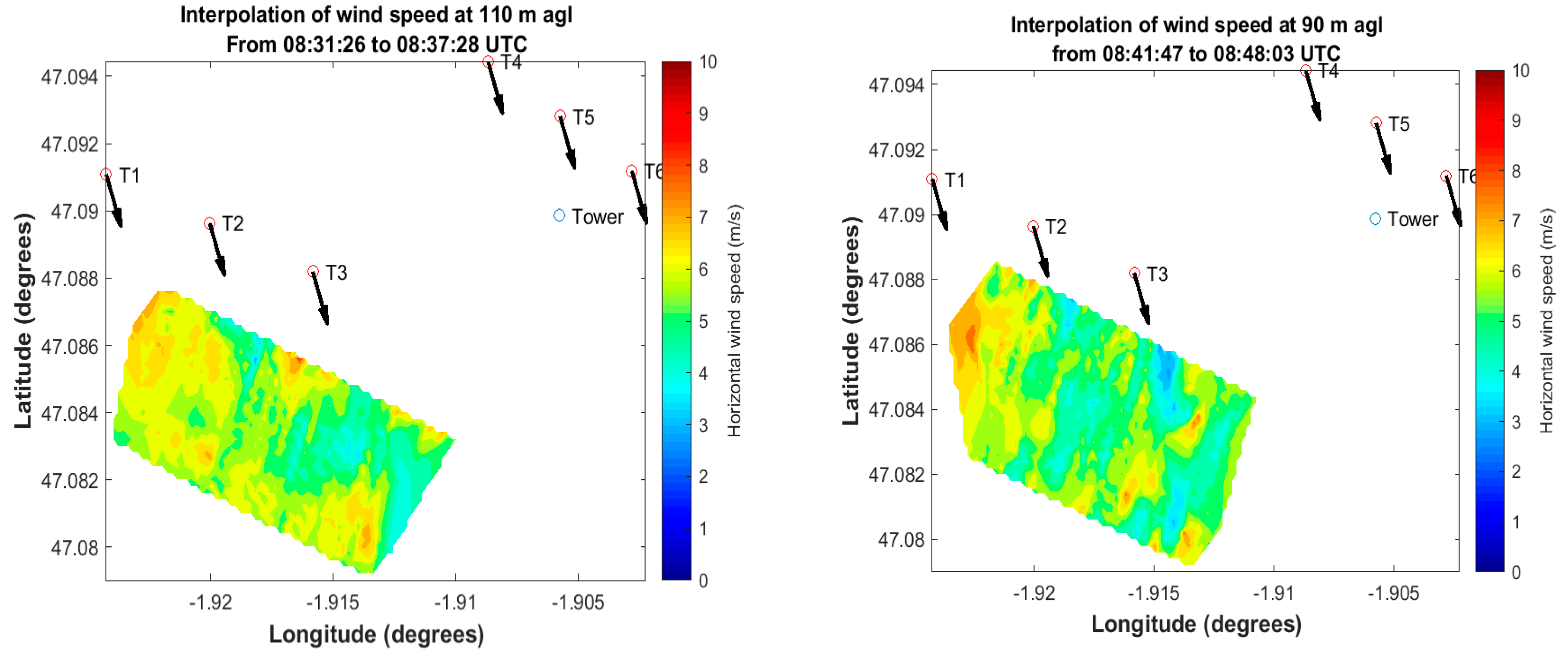

| Flight Date and Time | Flight Altitudes | Orientation of Racetracks and Number of Repetitions of Flight Phases | Comments | |
|---|---|---|---|---|
| 28 April 2021 8:22 to 11:07 UTC | 90 m and 110 m (agl) | Parallel to T1-to-T3 axis | 3 times | During the first part of the flight, either both T2 and T3 turbines or only the T2 turbine were stopped. |
| Almost south–north, east of T3 | 3 times | |||
| Perpendicular to T1-to-T3 axis | 3 times | |||
| 30 April 2021 7:45 to 9:45 UTC | 90 m and 110 m (agl) | Parallel to T1-to-T3 axis | 2 times | All turbines were functioning. |
| West–east | 2 times | |||
| Along the mean wind direction | 2 times | |||
Publisher’s Note: MDPI stays neutral with regard to jurisdictional claims in published maps and institutional affiliations. |
© 2022 by the authors. Licensee MDPI, Basel, Switzerland. This article is an open access article distributed under the terms and conditions of the Creative Commons Attribution (CC BY) license (https://creativecommons.org/licenses/by/4.0/).
Share and Cite
Alaoui-Sosse, S.; Durand, P.; Médina, P. In Situ Observations of Wind Turbines Wakes with Unmanned Aerial Vehicle BOREAL within the MOMEMTA Project. Atmosphere 2022, 13, 775. https://doi.org/10.3390/atmos13050775
Alaoui-Sosse S, Durand P, Médina P. In Situ Observations of Wind Turbines Wakes with Unmanned Aerial Vehicle BOREAL within the MOMEMTA Project. Atmosphere. 2022; 13(5):775. https://doi.org/10.3390/atmos13050775
Chicago/Turabian StyleAlaoui-Sosse, Sara, Pierre Durand, and Patrice Médina. 2022. "In Situ Observations of Wind Turbines Wakes with Unmanned Aerial Vehicle BOREAL within the MOMEMTA Project" Atmosphere 13, no. 5: 775. https://doi.org/10.3390/atmos13050775
APA StyleAlaoui-Sosse, S., Durand, P., & Médina, P. (2022). In Situ Observations of Wind Turbines Wakes with Unmanned Aerial Vehicle BOREAL within the MOMEMTA Project. Atmosphere, 13(5), 775. https://doi.org/10.3390/atmos13050775






